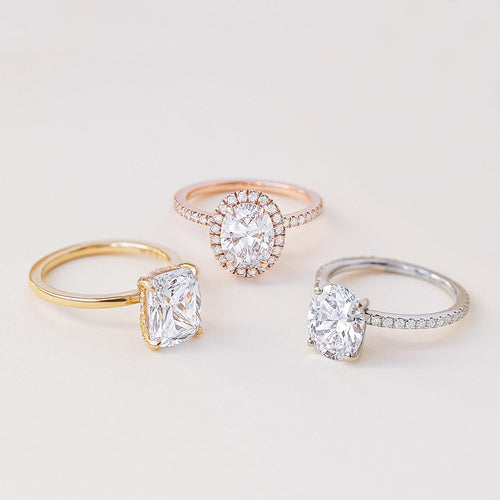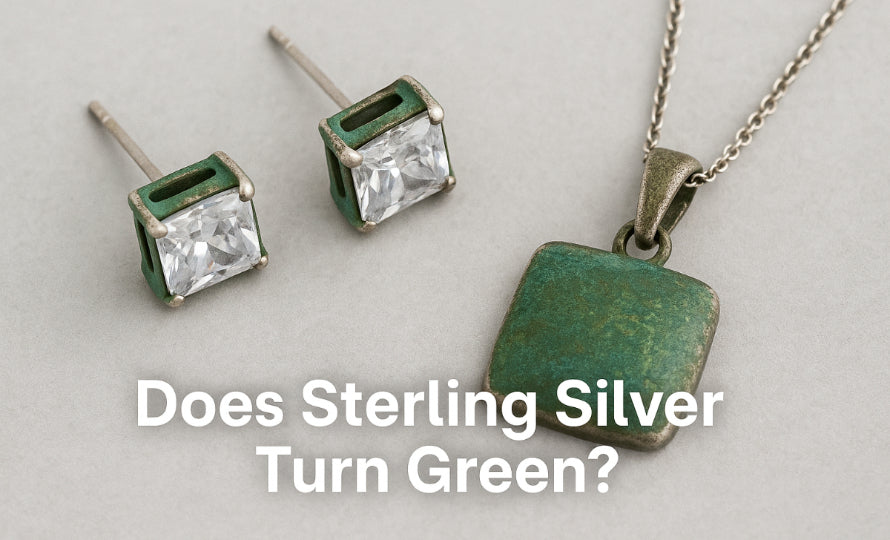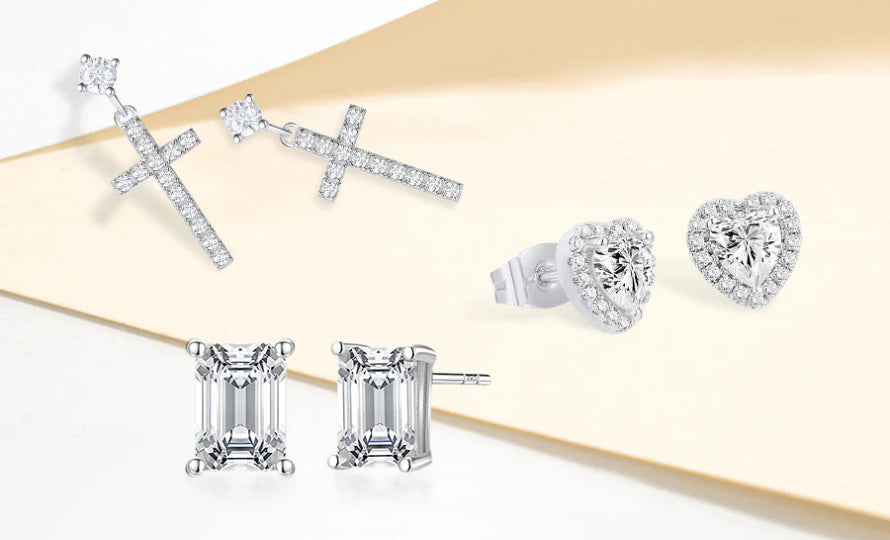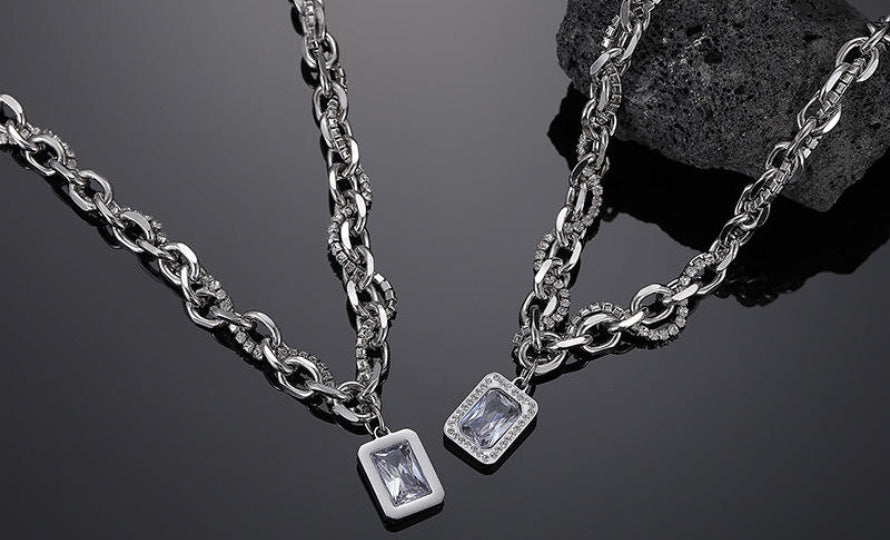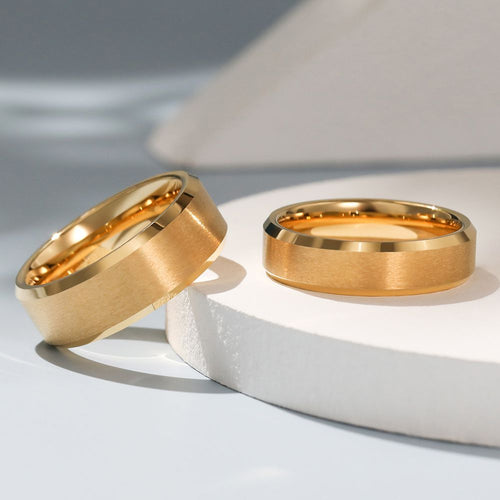Short answer: Sterling silver itself doesn’t “turn green,” but a small number of wearers may notice green skin where 925 silver touches. That color is usually from copper salts (sterling silver is 92.5% silver and ~7.5% copper). It’s cosmetic, harmless, and easy to prevent with smart habits, the right finish (e.g., rhodium plating), and regular light cleaning.
Table of Contents
What “Turning Green” Actually Means
When people ask “does sterling silver turn green,” they’re usually describing green residue on skin, not green metal. Sterling silver can darken (that’s tarnish—mainly silver sulfide), but green on skin is different: it’s typically a transfer of copper compounds formed when copper in the alloy reacts with moisture, sweat, skincare, or atmospheric chemicals. The residue wipes or washes off.
Key distinctions:
-
Green skin = copper salts on the skin’s surface.
-
Dark metal = tarnish on the jewelry’s surface.
-
Both are surface phenomena and reversible with proper care.

Does Sterling Silver Turn Skin Green? The Short Version
Yes, it can—on some people, some of the time. Sterling silver is 925 silver alloyed with metals like copper for strength. Copper is more reactive than silver, which is why certain conditions (high humidity, perspiration, skincare ingredients, chlorine) can produce greenish copper salts that transfer to skin. Many people will never experience it; others may notice it only in summer or during exercise. It’s not an infection or rash, and it doesn’t mean your jewelry is fake.
Why Some People Get Green Skin from Sterling Silver
1) Sweat, humidity, and body chemistry
Warm weather, workouts, and humid climates increase moisture and salts on the skin. This amplifies the natural reaction between copper and your environment, creating compounds that appear green when transferred.
2) Skincare and cosmetics
Lotions, sunscreens, perfumes, hair products, and hand sanitizers can alter your skin’s surface chemistry (pH, sulfides, chlorides). Some ingredients accelerate the formation or transfer of copper compounds.
3) Water exposure
Chlorinated pools, hot tubs, or sulfur-rich hot springs can push color changes quickly. Even tap water with high mineral content can contribute if the piece stays damp under rings or chains.
4) Friction and wear time
Rings that spin or slide, bangles that move constantly, and chains rubbing against skin can increase transfer. Longer wear without drying or wiping also adds up.
5) Non-silver components
Clasps, posts, or cores from a different base metal (especially nickel or brass on non-925 parts) can cause additional discoloration or irritation. Genuine sterling components should be marked 925/S925/.925.

How to Prevent Green Finger from Sterling Silver
Adopt “smart wear” habits
-
Last on, first off. Apply skincare, sunscreen, and perfume first; let them fully absorb/dry, then put on jewelry. Take jewelry off before cleansing or showering.
-
Keep it dry. Remove jewelry before swimming, hot tubs, workouts, or chores with chemicals. If it gets wet, dry thoroughly—including under ring bands.
-
Quick wipe after wear. A 5–10 second wipe with a soft microfiber or polishing cloth removes sweat and residues before storage.
Create a gentle barrier
-
After moisturizer is fully absorbed, you can use a clear jewelry shield (a purpose-made barrier coating) on the inner band for rings. It reduces direct metal-skin contact without permanently altering the piece.
-
Avoid relying on traditional nail polish long-term; it can chip, trap moisture, and degrade unevenly.
Choose protective finishes
-
Rhodium-plated sterling silver adds a bright, protective layer that reduces reaction with sweat and air. It may wear at high-friction spots over time; replating restores protection.
-
Some brands use anti-tarnish coatings; these can help but may need periodic renewal.
Store it right
-
Use airtight pouches or containers; press out excess air.
-
Add anti-tarnish strips or silica gel to combat humidity.
-
Store pieces separately to avoid scratches and chemical cross-contamination with rubber or leather.

Safe Ways to Clean Green Stains (Skin & Jewelry)
Always consider stones and settings first. Porous/soft gems (pearls, opals, turquoise, emeralds) and glued settings need gentle care. When unsure, start with the mildest method or ask a jeweler.
For skin (simple & safe)
-
Wash the area with mild soap and lukewarm water.
-
Pat dry, then apply a light moisturizer to support the skin barrier.
-
Avoid harsh scrubs or acids on recently discolored areas.
For jewelry (pick the lightest effective method)
Method A: Polishing cloth (light residue)
-
Gently buff all surfaces, rotating to a clean section of cloth as you go.
-
Rinse briefly, then dry completely.
Method B: Mild soap + soft brush (light to moderate)
-
Mix a few drops of mild dish soap in lukewarm water.
-
Soak for 2–5 minutes.
-
Use a soft brush (baby toothbrush) to clean crevices.
-
Rinse well and dry fully, including under stones and inside bands.
Method C: Baking soda + aluminum foil bath (moderate to heavy)
-
Best for unplated sterling without delicate stones or intentional oxidized finishes.
-
Line a bowl with aluminum foil (shiny side up).
-
Lay the piece so it touches the foil.
-
Sprinkle 1–2 tbsp baking soda per cup of hot (not boiling) water.
-
Add hot water to cover; let fizz 2–5 minutes, flipping for even contact.
-
Rinse thoroughly; dry completely.
-
Finish with a polishing cloth for mirror shine.
Method D: Professional clean / re-rhodium
-
For intricate filigree, mixed materials, set gemstones, or worn plating, a jeweler can ultrasonically clean, steam clean, or re-rhodium plate for like-new brightness and improved resistance.
What not to use
-
Toothpaste (abrasive, can scratch).
-
Bleach, ammonia, harsh powders, or anything labeled for “heavy-duty” metal cleaning that isn’t silver-safe.
-
Long soaks for pieces with glued settings or delicate stones.

Does All Sterling Silver Behave the Same?
Rhodium-plated sterling (925)
A thin rhodium layer (from the platinum group) gives a whiter, high-polish look and reduces contact between skin and the copper-containing alloy. It’s excellent for those prone to green finger, especially on rings.
“Hypoallergenic” claims
Sterling silver is generally nickel-free (check findings/posts/clasps). Nickel allergies cause redness/itching, not green residue. If you’re nickel-sensitive, confirm nickel-free components. Even with no nickel, copper salts can still leave green smudges on some skin types—manageable with the habits above.
Hallmarks & material quality
Look for 925/S925/.925 stamps and buy from reputable sellers. Avoid vague terms like “silver tone” or “silver color” that often indicate base-metal alloys with unpredictable reactions.
Green vs. Black: Green Finger vs. Tarnish
| Topic | Green on Skin | Black/Dark on Jewelry |
|---|---|---|
| What it is | Copper salts on skin | Silver sulfide (tarnish) on metal |
| Appearance | Light green smudge on skin | Gray/black film on jewelry |
| Main driver | Sweat, humidity, cosmetics | Sulfur compounds, air, humidity |
| Risk | Cosmetic only | Cosmetic; reversible |
| Fix | Soap + water, moisturize | Polishing cloth, mild soap, foil method |
| Prevention | Barrier + wear habits | Dry storage + regular wipe |
Takeaway: Green on skin ≠ bad silver; it’s chemistry. Black on jewelry ≠ damage; it’s removable tarnish.
Buying Guide: If You’re Prone to Green Finger
Consider finishes and materials
-
Rhodium-plated sterling for everyday rings and bracelets.
-
For ultra-sensitive wearers (or very humid climates), consider solid gold (14k+) or platinum for rings that stay on all day.
Check the components
-
Confirm nickel-free posts, backs, and clasps.
-
Choose stainless or sterling earring posts on silver earrings if you’ve reacted to mystery alloys before.
Fit matters
-
Rings that are too loose spin and trap more moisture; too tight can trap sweat under the band. Aim for a comfortable, secure fit.
Build a simple care kit
-
Silver polishing cloth, microfiber cloth, mild soap, airtight pouches, silica gel/anti-tarnish strips, optional jewelry shield for rings.
FAQs
Does sterling silver turn green on everyone?
No. Many people never experience green residue. It depends on skin chemistry, climate, and habits. If it happens occasionally, the solutions here will help.
Is green finger dangerous or permanent?
It’s cosmetic and temporary. Wash with mild soap and water; moisturize afterward. If you ever see redness/itching, that’s likely a nickel sensitivity from non-sterling components—switch to nickel-free.
How do I stop my ring from turning my finger green?
Keep jewelry dry, wear it after products have absorbed, wipe after wear, and consider rhodium-plated sterling or a jewelry shield on the inner band.
Does rhodium-plated sterling silver turn skin green?
It’s much less likely because rhodium reduces direct contact between skin and copper in the alloy. Over time plating can wear; replate high-friction areas as needed.
Why do my ears/neck turn green but not my fingers?
Different areas have different sweat, product exposure, and friction. Earrings and necklaces often contact hair products and perfumes, which can change surface chemistry.
Will the green stain go away on its own?
Yes—washing removes it quickly. Prevent recurrence with the wear/storage habits above.
Does sterling silver tarnish or rust?
Sterling silver tarnishes (darkens) but does not rust. Tarnish is removable; rust is iron-oxide (iron-based metals), which silver lacks.
Are there medical concerns involved?
Green residue alone isn’t a medical issue. If you experience persistent irritation, see a professional—especially to evaluate nickel allergy from non-sterling parts.
Conclusion
So, does sterling silver turn green? The metal doesn’t turn green—but your skin can, occasionally, due to copper salts formed under certain conditions. The good news is that it’s harmless, removable, and preventable. Choose rhodium-plated 925 if you’re sensitive, develop smart wear habits (keep it dry, last on/first off), and do quick wipe-downs before airtight storage. With a bit of routine care, your sterling silver will stay bright—and your skin will stay clear—day after day.
Ringsmaker Blog Tips
Readers are welcome to read the message and comments, and give their opinions, we will humbly adopt. Reproduction is prohibited without the permission of Ringsmaker.
Sample lookbook gallery
